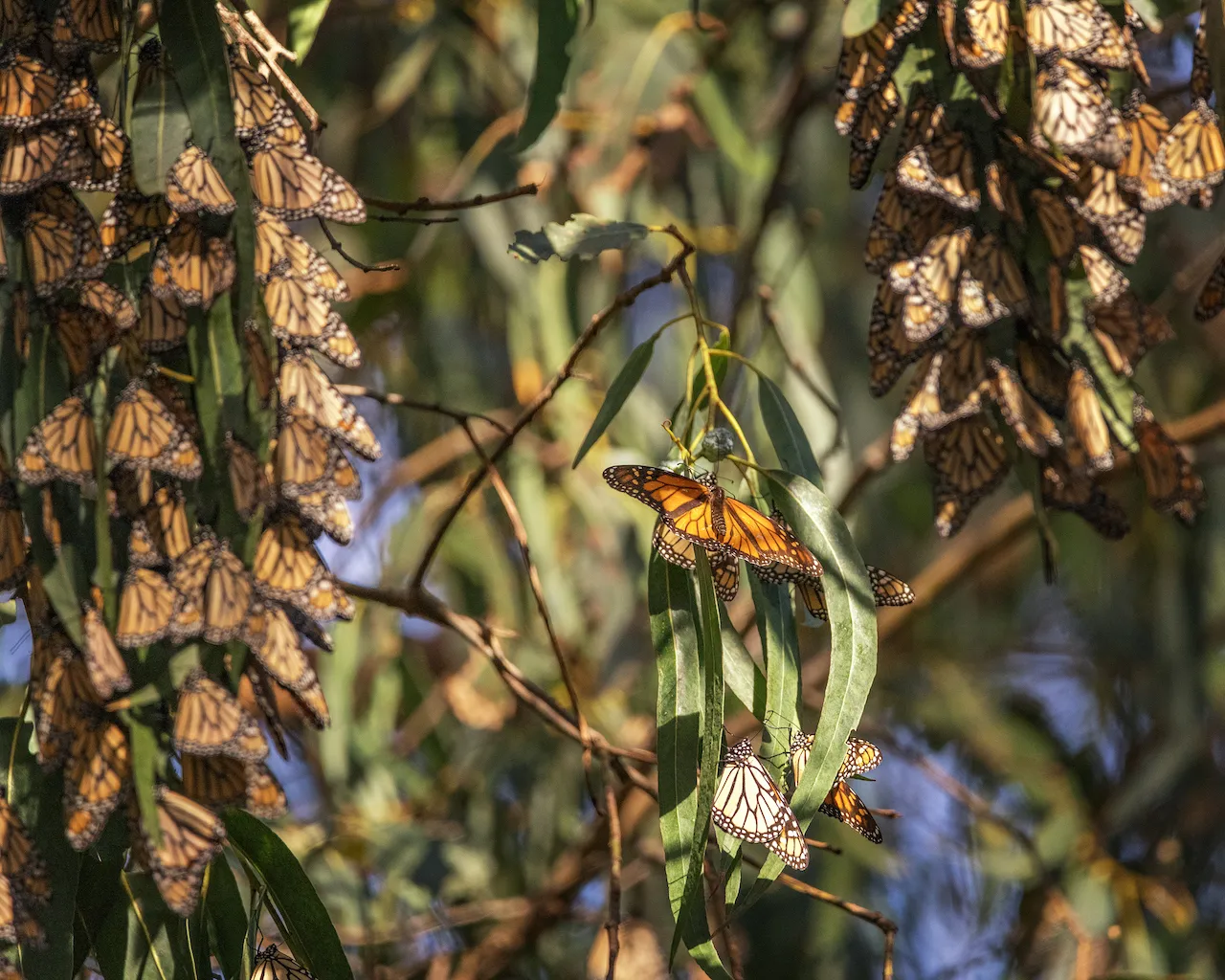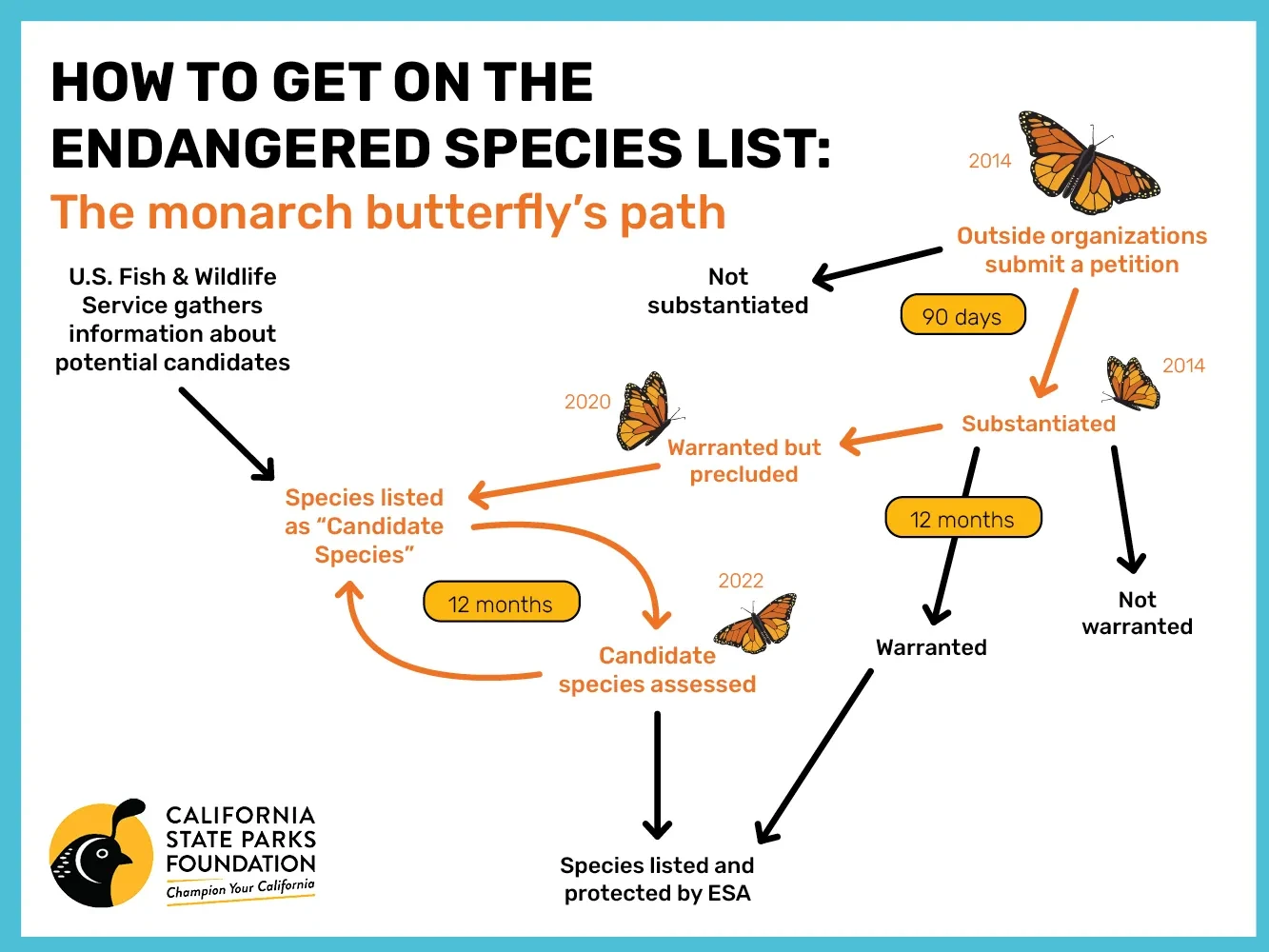In July 2022, the monarch butterfly was reclassified from “declining” to “endangered” on the International Union for Conservation of Nature (IUCN) Red List of Threatened Species. The IUCN Red List is a widely used and highly regarded global resource that highlights imminent threats to the survival of various species. It is not, however, a legal classification, and the monarch butterfly is not listed under either the Federal Endangered Species Act (ESA) of 1973 or the California Endangered Species Act (CESA). This is an important distinction because the ESA holds the power to establish legal protections; create and implement recovery plans; provide interagency cooperation to limit hunting, collecting, or trading species; and authorize financial support for these efforts. Unfortunately, the IUCN Red List and the ESA do not always overlap — the IUCN lists far more species than the ESA — and the monarch butterfly is an example of how the critical needs of vulnerable species can outpace the ESA’s capacity to provide protection.
At California State Parks Foundation, we’ve been working to protect a specific population of monarchs that call our state parks home — the western monarch butterfly. The western and eastern monarch populations are separated by the Rocky Mountains, and both are at risk of becoming endangered, but scientists and lawmakers classify them as the same species. Western monarch butterflies have experienced a sharp population decline due to habitat loss, pesticide use, and climate change, warranting their protection. In just a few days, volunteers will take to California’s coast to participate in the Xerces Society’s annual Western Monarch Thanksgiving Count (WMTC), which was established in 1997 to monitor the population’s vulnerability. Scientists, conservation groups, community members, and volunteers have had their eyes on western monarchs for decades now, watching them decline from the millions in the 1980s to 1,899 in 2020. The 2021 WMTC reported 247,237 individuals, marking a considerable increase in population, a positive sign for an otherwise declining population. This increase, however, does not reverse the overall downward trend in the western monarch’s population, and the species as a whole is still being monitored closely to determine if it should be protected federally.
How does a Species Gain Protection Under the Endangered Species Act?
In order for a species to be listed under the ESA, U.S. Fish & Wildlife Service (USFWS) must receive a petition or start an investigation into a species on its own. The agency must then review the case and release a finding within 90 days on whether the species listing is warranted. For the monarch butterfly, this process began in 2014, when several environmental organizations petitioned for the species to be listed under the ESA. The monarch butterfly has been listed as a candidate species ever since, holding it in limbo while USFWS reviews the status of its population and threats each year to determine if it will be added. In the agency’s most recent annual findings, it "determined that the monarch butterfly (Danaus plexippus) warranted listing as an endangered or threatened species under the Act, but that listing was precluded by higher priority listing actions.” This report was released before the IUCN reclassified the monarch as “endangered,” but it is not yet clear if this update will influence USFWS to move forward with listing it itself.
Although monarchs have not yet been protected federally or by the CESA, they do have some legal protections at the state level, including:
-
Listed as Sensitive on the California Department of Fish and Wildlife (CDFW)’s Terrestrial and Vernal Pool of Invertebrates of Conservation Priority
-
Listed as a Species of Greatest Conservational Need on California’s State Wildlife Action Plan
-
Protected under California Fish and Game Code and California Code of Regulations Section (1002) and California Code of Regulations Title 14 Sections 650 (a) and (b), which outlaw the possession or removal of monarchs without a Scientific Collection Permit from the CDFW.
-
The California Coastal Commission designates all overwintering sites within the Coast Zone to be Environmental Sensitive Habitat Areas, though many Local Coastal Plans do not include this designation.
The responsibility to safeguard the western monarch butterfly falls to all of us, especially while it is not currently protected by ESA or CESA. To learn more about western monarchs and California state parks, visit our page with videos and more here.
Donate this Giving Tuesday to help support our monarch conservation work and the state parks they rely on! Your gift today will ensure that everyone can enjoy this iconic species and parks for generations to come.
Sources:
-
Is the monarch butterfly now listed as endangered? Santa Monica Daily Press, 2022
-
State and Federally Listed Endangered and Threatened Animals of California State of California, Natural Resources Agency, 2022
-
Migratory monarch butterfly now Endangered - IUCN Red List IUCN, 2022
-
Conserving imperiled species: a comparison of the IUCN Red List and U.S. Endangered Species Act Harris, Reid, Scheffers, Wanger, Sodhi, Fordham, & Brook, 2011
-
Listing a Species as Threatened or Endangered: Section 4 of the Endangered Species Act U.S. Fish & Wildlife Service, 2016
-
Endangered Species Act U.S. Fish & Wildlife Service, 1973
-
Endangered and Threatened Wildlife and Plants; Review of Species That Are Candidates for Listing as Endangered or Threatened; Annual Notification of Findings on Resubmitted Petitions; Annual Description of Progress on Listing Actions U.S. Fish & Wildlife Service, 2022
-
Is The Monarch Butterfly Now Listed As Endangered? California Department of Fish and Wildlife, 2022
-
Listed Species Summary (Boxscore) Environmental Conservation Online System, 2022
-
IUCN Red List of Threatened Species IUCN Red List, 2022

